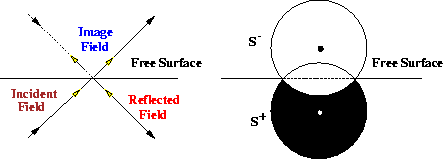![[*]](http://sepwww.stanford.edu/latex2html/cross_ref_motif.gif) -a).
-a).
When applied to the grid-points near the surface, the spatial operators
are folded back (reflected) in the following way: The part of the operator
that operates in the z component of the wavefield retains its original
polarity, while the part that operates in the x component has its polarity
reversed (see Figure ![[*]](http://sepwww.stanford.edu/latex2html/cross_ref_motif.gif) -a).
-a).
 |
The source term is introduced as an additive contribution to the
wavefield at the source location, during the time span in which the
source is considered active. To avoid spatial aliasing (and also to allow
the definition of a pressure source) the source needs to be spatially
smooth, that is, covering a determined region of space.
When the source is located sufficiently close to the surface (as is usually
the case in the real world) the free-surface image of the source will
be also active in the bottom space where the model is defined, as
Figure ![[*]](http://sepwww.stanford.edu/latex2html/cross_ref_motif.gif) -b shows. Therefore, the source term needs to be
introduced as the sum of the contributions of the real source and of its
image in the model space region.
-b shows. Therefore, the source term needs to be
introduced as the sum of the contributions of the real source and of its
image in the model space region.